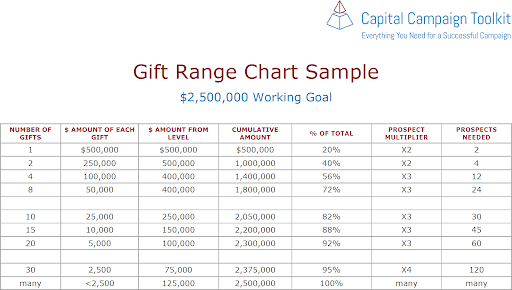A guest post by Amy Eisenstein and Andrea Kihlstedt of Capital Campaign Pro
You may believe that a capital campaign begins when you start asking people for gifts. Or perhaps you think it starts once you have a glossy campaign brochure that you can use to ask for gifts.
But capital campaigns begin long before that. Work on your campaign actually begins in the pre-fundraising period, a period we think of as Pre-Campaign Planning.
The Pre-Campaign Planning process begins when your board decides that your organization should launch a capital campaign and ends when you have a solid enough campaign plan to test with your largest donors. That testing process—whether a traditional feasibility study or one of the newer variations—will help you determine whether the campaign plan you developed is viable.
If it is, you will proceed with the campaign itself, identifying prospects, building relationships, laying out fundraising calendars and more. If it’s not, you’ll reconfigure your plans.
So what goes into a preliminary campaign plan, the one you will test with your donors?
Step 1: Assess Your Readiness
Take some time to evaluate your organization’s readiness for a campaign:
Take Capital Campaign Toolkit’s free readiness assessment here.
This will give you a sense of the areas you need to ramp up now in the early stages of your planning. Ask the appropriate people to fill out copies, and see how their answers compare. The assessment will help you think through what needs to be done and will serve as the basis for constructive conversations about what is to come.
Step 2: Establish a Core Committee
The Core Committee is the small group of 4-6 people who move the campaign planning forward. That group will grow and change throughout the campaign, but the original people usually play an important behind-the-scenes role in determining the shape and direction of the campaign.
During the early planning, the Core Committee should include the executive director, board chair, development director and a couple of other board members or involved major donors.
Step 3: Determine the Working Goal
The working goal for your campaign is an early assessment of how much money you would like to raise through your campaign with the understanding that goal may change over the course of the campaign.
Start by making a list of your campaign objectives, the things you will spend the money you raise on. Estimate the cost of each of them and add up your list. Then add about 10% more for your campaign expenses. No need to dig into budgeting and fine details just yet—your goal can and likely will shift as your campaign comes into focus.
Step 4: Create a Gift Range Chart
Using the working goal from Step 3 as a base number, create a gift range chart that shows how many gifts you will need at various giving levels to reach your campaign goal.
Your top gift should be at least 20% of your working goal, but if you have a small donor base, it might be higher. Work down, increasing the number of gifts and decreasing the gift amounts. Use standard giving levels like $500,000, $250,000, $100,000 etc. Make sure that the number of individual gifts increases for each giving level.
Your chart should have approximately 8 levels of giving, and the amount raised from all of those gifts should add up to the campaign goal, like in this example:
Step 5: Identify 30 Qualified Prospects for the Top 10 Gifts
For your campaign to succeed, you’ve got to be able to identify approximately 10 people who have the ability and inclination to make significant gifts, a belief in your mission, and a real and direct contact with your organization.
Your campaign plan should include a list of enough qualified prospects so that you can reasonably anticipate that one third of them may actually make the largest gifts. We recommend gathering 30 qualified prospects for the top 10 gifts in your gift range chart.
Step 6: Create a Depth Chart
A depth chart is simply a way of sorting the list of prospects according to their giving capacity. A chart like this should use the giving levels you devised in Step 4 for the gift range chart to sort individual prospects into different potential giving levels:
The process of creating this chart will help you evaluate the possibility of reaching the working goal you have developed. If you find that you can’t identify enough qualified prospects for your top giving levels, you may have to reconsider your working goal and gift chart.
Step 7: Engage Your Top Prospects
Once you have identified your largest and most likely lead donors, you’ll create a plan to engage each of them. You can do this in many ways. You might:
- Meet with them individually to discuss your early plans.
- Invite them to participate in small focus groups.
- Ask them to serve on an ad-hoc planning committee.
The main idea is that these people, the likely largest donors to your campaign, should be personally involved in planning prior to being asked to make a gift. There’s no need for email promotion strategies and other marketing plans yet. Engaging these prospects during the pre-campaign and quiet phases is all about one-on-one conversations.
Step 8: Draft a Case for Supporting Your Campaign
Your early campaign plan must include a draft of your case for support. This should be a simple word document that describes why people might make generous gifts to your campaign. How will the people you serve benefit from your campaign? A powerful case for support must inspire people to give, and you will likely have to go through many drafts to arrive at one that is clear and compelling.
Step 9: Prepare Your Board
Though your board members have probably been involved in developing the strategic plan that has led you to a campaign, chances are good that very few of them know what’s involved in a capital campaign. But they will be on the line for the campaign’s success and so should understand what will be expected of them.
In this early planning process, you should begin to educate them about what a capital campaign is and what roles they will be expected to play, whether that’s sourcing and cultivating prospects, soliciting gifts, running your public phase social media strategies, planning events or more.
Now It’s Time to Test Your Plan
Follow these nine steps and you will have a preliminary campaign plan that you can test with your largest donors and most influential community members. Do this with a feasibility study.
By discussing your plans with your prospective donors and community influencers you will learn what they think about what you propose. If you use a traditional feasibility study model, you’ll hire a consulting firm to interview your key prospects and community leaders. The Capital Campaign Toolkit has pioneered a very successful new approach, Guided Feasibility Studies, in which expert advisors help you structure the feasibility study process, but you meet with your donors personally.
Whichever model you choose, this step in the campaign process is extremely important since it will set you on the road to success based on real data gathered from your donors.
Amy Eisenstein, ACFRE, and Andrea Kihlstedt are co-founders of the Capital Campaign Toolkit, a virtual support system for nonprofit leaders running successful campaigns. The Toolkit provides all the tools, templates, and guidance you need — without breaking the bank.



